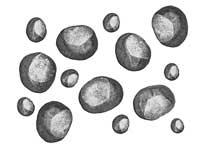Chestnuts Chestnuts

In fact, chestnuts and cereals are very similar in terms of composition, although many compare them unconsciously with nuts. They have a high proportion of carbohydrates (37.4%), as well as legumes and cereals. These carbohydrates are mainly formed by starch and in very small amounts by sucrose.
Therefore, it is recommended to chew chestnuts very well to facilitate the digestion of starch and thus avoid the wind and heaviness of the stomach. The proportion of proteins (2.42%) is similar to fat (2.26%), being most monkeys or polyunsaturated. The chestnut has 213 kcal per 100 g, more than the potato (79 kcal/100 g), but much less than nuts (642 kcal/100 g). As for mineral salts, chestnut has a lot of potassium and little sodium, so they are recommended for people with problems of hypertension. Also noteworthy is the amount of iron, magnesium, calcium, phosphorus and zinc. The vitamins of group C and B are very abundant.
For all the above, chestnuts are considered as muscle stimulants, alkalizing and galactogens (milk producers). They are especially recommended:
- Because when there is a lot of physical fatigue they produce a toning effect on the muscles.
- Increased amount of acid in the blood due to kidney problems (uric acid and urea, among others). Chestnuts are alkalizing so they neutralize this excess of acid in blood.
- For breastfeeding women, in addition to increasing milk production, due to the abundance of obligatory nutrients that women have in this situation.
And at the time of the year we are, they are suitable for anyone, 3-4 times a week, about 10 chestnuts cooked or roasted. Yes, as we said before, eating slowly and chewing well.
Buletina
Bidali zure helbide elektronikoa eta jaso asteroko buletina zure sarrera-ontzian











